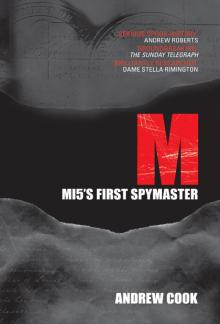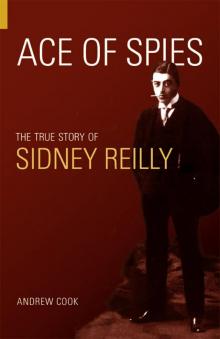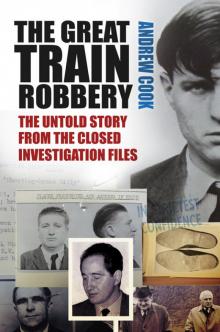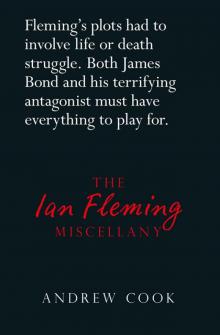- Home
- Andrew Cook
Ace of Spies Page 2
Ace of Spies Read online
Page 2
I direct that my funeral and testamentary expenses and debts be paid. I give devise and bequeath to my said wife for her own absolute use and benefit all my real estate and the residue of my personal estate and all the property over which I have any power of disposition and whereas in the event of issue being born to me of my said wife Margaret such issue will under the Will of my late uncle, Hugh Thomas of Trevor Anglesey aforesaid become entitled to certain real estate and personal estate. Now I hereby declare that the gift devise and bequest to my said wife here in before contained shall include all real and personal estate which I may have power to dispose of as heir at law or next of kin of any such issue as aforesaid and I give devise and bequeath the same to my wife accordingly for her own absolute use and benefit.9
Margaret also made a Will, assigning Henry Lloyd Carter as Executor. On the morning of Friday 11 March, exactly one week after making the Will, Hugh Thomas and his nurse, Anna Gibson, left Upper Westbourne Terrace bound for Victoria Station. Arriving at Newhaven Harbour Station during the late afternoon, their trunks were put into storage and the hand luggage taken to their adjoining rooms. Little did Hugh Thomas know, as he retired to bed early, that he had less than twelve hours left to live.
Saturday 12 March was a cold and wet day and the Reverend Thomas and his nurse were confined to the hotel. He retired to bed shortly before 11.00 p.m. It was early the following morning that John Simmons knocked on the door of the Reverend Thomas’s room; being an invalid, he had ordered breakfast to be served in his room. Getting no reply to his knocking, Simmons used his key to open the door. Inside the room was dark and seemingly all was normal.
Having seen a good number of slumbering guests in the three years he had worked at the hotel, Simmons’ instinct quickly told him that something was not as it should be. He therefore rushed from the room to alert the hotel manager, Alfred Lewis.10 It took a further half-hour before Lewis telephoned the Newhaven police to report that the Reverend Hugh Thomas had been found dead in bed. This was probably because his first reaction was to summon the Reverend’s nurse and a doctor, who by chance was also staying at the hotel, having arrived late the previous evening. Dr T.W. Andrew examined the body of Hugh Thomas and spent some time talking with Anna Gibson, the nurse, before advising Lewis that the death was the result of heart failure.
Hugh Thomas’s body was taken to a Chapel of Rest, and it may well have surprised the undertaker that, on her arrival the next day, Margaret voiced her intention to have her husband taken back to his place of birth in Anglesey for burial, rather than to London. What might have surprised him even more was the speed at which Mrs Thomas wanted the arrangements made. Eight to ten days was not an unusual period of time from death to burial in 1898, yet Margaret wanted a funeral on Wednesday 16 March, which gave the undertaker a mere day and a half to carry out the necessary rituals, make a coffin and convey the body to its final resting place in Llansadwrn Church Yard.11
Not surprisingly, Hugh Thomas’s death caught the attention of the local press, much to the concern of Alfred Lewis, the hotel manager, who no doubt resented the unwelcome attention such a story brought to his hotel. It is interesting to note that one journalist referred in his account to the fact that ‘a young medical man having been able to certify the cause of death, it was not deemed necessary to hold an inquest’.12
Six weeks later, probate of the Will of Hugh Thomas was granted to Margaret, who became the inheritor of £8,09412s (something in the region of half a million today). If Henry Lloyd Carter, Hugh Thomas’s solicitor and co-executor of the Will, had any doubts arising from the fact that the Reverend had expired within nine days of writing the Will, or indeed the fact that he was buried within three days of his sudden death, he did not say so publicly, and possibly did not say so privately either. Had he done so, and the authorities had conducted an investigation, what would they have discovered?
The police would, initially, have wanted to be sure about the cause of death. According to Dr Andrew, the cause of death was ‘Influenza Morbus Cordis Syncope’, which essentially means ‘influenza; a fainting of the heart’.13 It is as non-specific a diagnosis as is possible to record and most certainly one that would not be acceptable today. It could encompass virtually any heart condition, and taken literally and logically means quite simply that death occurred because the heart stopped beating!
The police would therefore have wanted to establish a more precise cause of death. They would have wanted to interview the Reverend Thomas’s own doctor about his general state of health, and most certainly Dr Andrew. It would have been at this point that what began as a routine enquiry would have turned into something more serious, for they would quickly have discovered that no such person as Dr T.W. Andrew MRCS actually existed.14 The Royal College of Surgeons, with whom Andrew claimed membership, would have confirmed that no one of that name was a member of the college. The General Medical Council would have consulted its register, which listed all doctors authorised to practice medicine in Great Britain. No T.W. Andrew MRCS would have been found there either. The police may well have contacted Dr Thomas Andrew LRCS, the only T. Andrew on the register.15
Hugh Thomas during his tenure as Vicar of Old Newton, Suffolk (c.1860).
They would have found that this sixty-one-year-old doctor from Doune in Perthshire had not crossed the border into England during the entire thirty-six years that he had been practising medicine. Besides which, it would have been very obvious that this elderly Scotsman could not possibly have been the ‘young medical man’ referred to by the Sussex Express or the man recalled by Louisa Lewis, the daughter of the hotel manager.16
In light of this disturbing development, the police would have proceeded to interview Margaret Thomas, Anna Gibson, other members of the below-stairs household, and friends and acquaintances of the Thomases. They would also have taken steps to have the body of Hugh Thomas exhumed to confirm the cause of death.
From what is known of Margaret’s personality, she would probably have held up well under the pressure of questioning. It is likely, however, that others interviewed would have mentioned a Mr Rosenblum and the fact that he was a regular visitor to the Thomas household, both at Upper Westbourne Terrace and at the Manor, Kingsbury. Would the police have harboured any suspicions about the purpose of his visits and his relationship with Margaret Thomas? Would the fact that Sigmund Rosenblum was a consultant chemist, and a Fellow of the Institute of Chemistry and the Chemical Society, with easy access to drugs, further fuel their suspicions? Would the police have made a connection between the ‘young medical man’ and the young chemist? The police may well have stumbled on the fact that the twenty-five-year-old Rosenblum had been in the country for a little over two years and was ‘known’ to Scotland Yard’s Special Branch.
Of course, no such investigation ever took place, much to Sigmund Rosenblum’s very great fortune. However, looking at all the available evidence, what can we conclude was the likely chain of events over the weekend of Hugh Thomas’s death?
Assuming that Thomas’s death was not a convenient and timely coincidence, we must consider the issues of motive, method, and opportunity. For Sigmund Rosenblum, Hugh Thomas was an inconvenient obstacle who stood between him and the achievement of two major ambitions. With Thomas’s death, Margaret would not only become a widow but a very rich widow, and by marrying Margaret, Rosenblum would achieve at least one ambition and effectively gain control of her new fortune. Rosenblum’s second ambition, the achievement of a new identity, would also benefit from this marriage.
A further motivational clue in terms of the timing of Thomas’s death is possibly concealed within his Will. Fourteen innocuous words raise a scenario never before suggested – ‘in the event of issue being born to me of my said wife Margaret’. Was this merely wishful thinking on the part of a sixty-three-year-old man with Bright’s Disease, or were his words motivated by the fact that Margaret was already pregnant? According to London lawyers Kingsford, Stacey, Blackwell, who
studied the contents of the Will, this passage is very significant as, ‘it is not a standard clause or a clause that would have been included in error, as it refers to his issue receiving a share of the estate of his uncle which is quite specific’.17 If Margaret was pregnant, it is more likely to be by Rosenblum than Hugh Thomas. If nature had been allowed to take its course, the child may well have betrayed its paternity. After all, as Gordon BrookShepherd pointed out in his book Iron Maze, Reilly himself was someone whose Jewish heritage was, ‘written in capital letters on his face’. Had the child’s parentage been equally obvious, Margaret would surely have been divorced and cut off without a penny, hardly a scenario that she or Rosenblum would have welcomed. If Margaret had found herself pregnant in late 1897, the forthcoming holiday might well have presented the perfect cover for Thomas’s death. Indeed, Margaret, who had arranged the holiday, was conveniently absent from the London & Paris Hotel over that critical weekend, having left London four days after her husband.
Furthermore, it is unlikely that Rosenblum could have plotted the demise of Hugh Thomas without the assistance and connivance of Margaret. Margaret was by this time very much under Rosenblum’s spell and very much in love with him, as evidenced by anecdotal accounts from, among others, British diplomat HM Vice-Consul Darrell Wilson (see Chapter Five). Assuming that Thomas had been suffering from Bright’s Disease for some eight years, Rosenblum may well have decided to use the symptoms of the disease as a convenient cover for slow and progressive arsenic poisoning, the results of which would appear very similar to those of Bright’s Disease. Both progressive arsenic poisoning and Bright’s Disease would have resulted in a swelling of the limbs, especially the legs, caused by fluid retention; a loss of appetite; and blood in the urine.
The poison could have been administered progressively through the patent medicine he was supplying to Hugh Thomas. Equally, Margaret could also have administered it on Rosenblum’s instructions through food and drink. Neither possibility, however, would account for or enable the fatal dose to be administered at the London & Paris Hotel on the night of Saturday 12 March. If we assume that Rosenblum was at the hotel in the guise of Dr T.W. Andrew,18 he would not have wanted to risk being seen by or in the vicinity of Hugh Thomas, or risk direct involvement in administering the fatal dose. With Rosenblum keeping a low profile and Margaret sixty miles away in London, we must take a closer look at Anna Gibson who, after all, was best placed in terms of opportunity, being Thomas’s nurse and occupying the neighbouring room.
News of Thomas’s sudden death was very quickly picked up by the local press.
According to Thomas family records, Miss Anna Gibson was a twenty-eight-year-old born in Clerkenwell, London, who joined the household in March 1897. This would mean that her date of birth would have been somewhere between March 1868 and April 1869. An exhaustive search of birth records for an Anna Gibson during that period reveal only one person of that name, who was born in Blofield in Norfolk. As this Anna Gibson was not born in London, let alone Clerkenwell, we must either assume an error or omission in the records or that, for whatever reason, Anna misled the family about her name, age or place of birth. The nearest national census to Anna’s year of birth was 1871. By methodically searching the Clerkenwell census returns for two-year-old girls by the name of Anna, we find only one such candidate – Anna Luke, daughter of William and Elizabeth Luke. Anna Luke’s birth certificate shows that she was born on 5 January 1869, and more revealingly that her mother’s maiden name was Gibson.19
Can we therefore assume that the Anna Gibson employed by the Thomas household and Anna Luke are one and the same? If so, what motive or reason could Anna have had for adopting her mother’s maiden name? The answer may lie in the circumstances surrounding Anna’s departure from her previous position in Japan, where she had held a post working for a wealthy family. Shortly before Anna’s return to England, a crime passionnel hit the headlines in the Japanese press. In Yokohama, on 22 October 1896, Walter Carew died of arsenic poisoning, and his wife was arrested amid a storm of publicity. As it later emerged in court, Mrs Carew had been having an affair with a young bank clerk. Although found guilty and sentenced to death, Mrs Carew’s sentence was commuted and she was sent back to England to serve out her sentence at Aylesbury Prison. At her trial she maintained her innocence and continued to do so on her release from prison in 1910. Until the day she died at the age of ninety in June 1958, she was to maintain that one ‘Anne Luke’ had been involved in her husband’s death.
To tell the full story of the Carew case, with its many twists and turns, would require a book in its own right. In the context of Hugh Thomas, however, the central question is whether or not there is any tangible evidence to connect ‘Anna Gibson’ with the Carew case. If Anna Gibson spent two years in Japan, and returned to England in late 1896 or early 1897, she must have initially left in late 1894 or early 1895. An exhaustive search of British passport records indicated that no passports were issued to anyone under the name Gibson during late 1894 and early 1895. However, a second search undertaken for the name Luke revealed that on 13 December 1894 a passport was indeed issued to ‘A. Luke’.20 While there is no conclusive proof that Anna Gibson was Anna Luke, or that she was involved in Carew’s death, the circumstantial evidence does point very strongly to this conclusion.
Had Rosenblum somehow discovered Anna’s secret and involved her, willingly or unwillingly, in the plot? Towards the end of her life, Margaret spoke of a ‘great wrong’ she had committed earlier in her life, which preyed on her conscience. Was this perhaps a reference to her involvement in the death of her first husband?21
Rosenblum, however, was a man without a conscience. The planning and execution of the Thomas murder had all the hallmarks of the skilful cunning, deceit and daring that characterised his later career. If ever there was such a thing as a perfect murder, this is surely a prime candidate. On 22 August 1898 he married Margaret Thomas at Holborn Registery Office. The marriage brought not only the wealth he desired but provided the pretext for the fulfilment of his second major ambition, to discard Sigmund Rosenblum and assume the identity that was to bring him such notoriety: that of Sidney Reilly. This new and plausible identity was, as we shall see later, the key to achieving his desire to return to the land of his birth.
TWO
THE MAN FROM NOWHERE
Sigmund Rosenblum’s identity and origins have confounded writers, researchers, governments and their intelligence agencies for well over a century. It has almost become an accepted fact that his real name was Sigmund Rosenblum, partly because of the sheer number of times that this ‘fact’ has been repeated and printed over the passage of time. Many authors have written about Reilly’s origins and his supposed family background. According to Robin Bruce Lockhart, Reilly was born, ‘not far from Odessa’.1 EdwardVan Der Rhoer similarly has his birth, ‘in Odessa, a Black Sea port’,2 as do John Costello and Oleg Tsarev.3 Michael Kettle, however, claims his place of birth to be Russian Poland,4 an assertion supported by Christopher Andrew5 and Richard Deacon.6
Reilly himself told numerous stories about his supposed origins. He was, at different times, the son of: an Irish sea captain; an Irish clergyman; or a Russian aristocrat. His first wife Margaret was under the impression that he was the son of a wealthy landowner and came from Poland or Russia.7 In his book, British Agent, Robert Bruce Lockhart, an envoy sent to Russia by Lloyd George in 1918, stated that Reilly’s parents came from Odessa, although he made no pronouncements upon Reilly’s own place of birth.8 Among the places in Ireland Reilly claimed to have been born were Clonmel in Tipperary and Dublin.9 While accompanying Brig.-Gen. Edward Spears on a business trip to Prague in 1921, however, Reilly was alleged to have lunched at the British Legation where he recounted stories of his childhood in Odessa. When asked by a Legation official why it was that his passport gave his place of birth as Tipperary, Reilly apparently replied, ‘There was a war and I came over to fight for England. I had to have a British pas
sport and therefore a British birthplace, and, you see, from Odessa, it’s a long way to Tipperary!’10 He told Pepita Bobadilla, whom he married in 1923, that being born in Ireland was a cover, and that he had actually been born and educated in St Petersburg, of an Irish merchant seaman and a Russian mother.11
Not only was Reilly’s place of birth a mystery, but so too was his age. In 1931 Pepita Bobadilla stated in the first edition of her biographical account of Reilly that he was born in 1872.12 When she published a longer version in book form, his year of birth became 1874.13 Robert Bruce Lockhart stated that when they first met, Reilly was in his forty-sixth year, indicating 1873 as his year of birth.14
Marriage certificates, immigration documents and passports prior to 1917 equally point to 1873 as being his year of birth.15 From the date of his recruitment into the Royal Flying Corps (RFC) in late 1917, however, Reilly gives 1874 as his year of birth on all official documents.16 It has been suggested that the main motivation for these conflicting stories was a desire to protect his family, as he was engaged in espionage on behalf of a foreign power, and was thus anxious for their safety should this ever become known.17 The more we discover about Reilly’s real motivations and behaviour in the ensuing years, however, the more we are led to an alternative theory, namely that he had little or no interest in his family or their fate after he left them, and that instead he was more concerned with masking his Jewishness.18

 M
M Ace of Spies
Ace of Spies The Great Train Robbery
The Great Train Robbery The Ian Fleming Miscellany
The Ian Fleming Miscellany